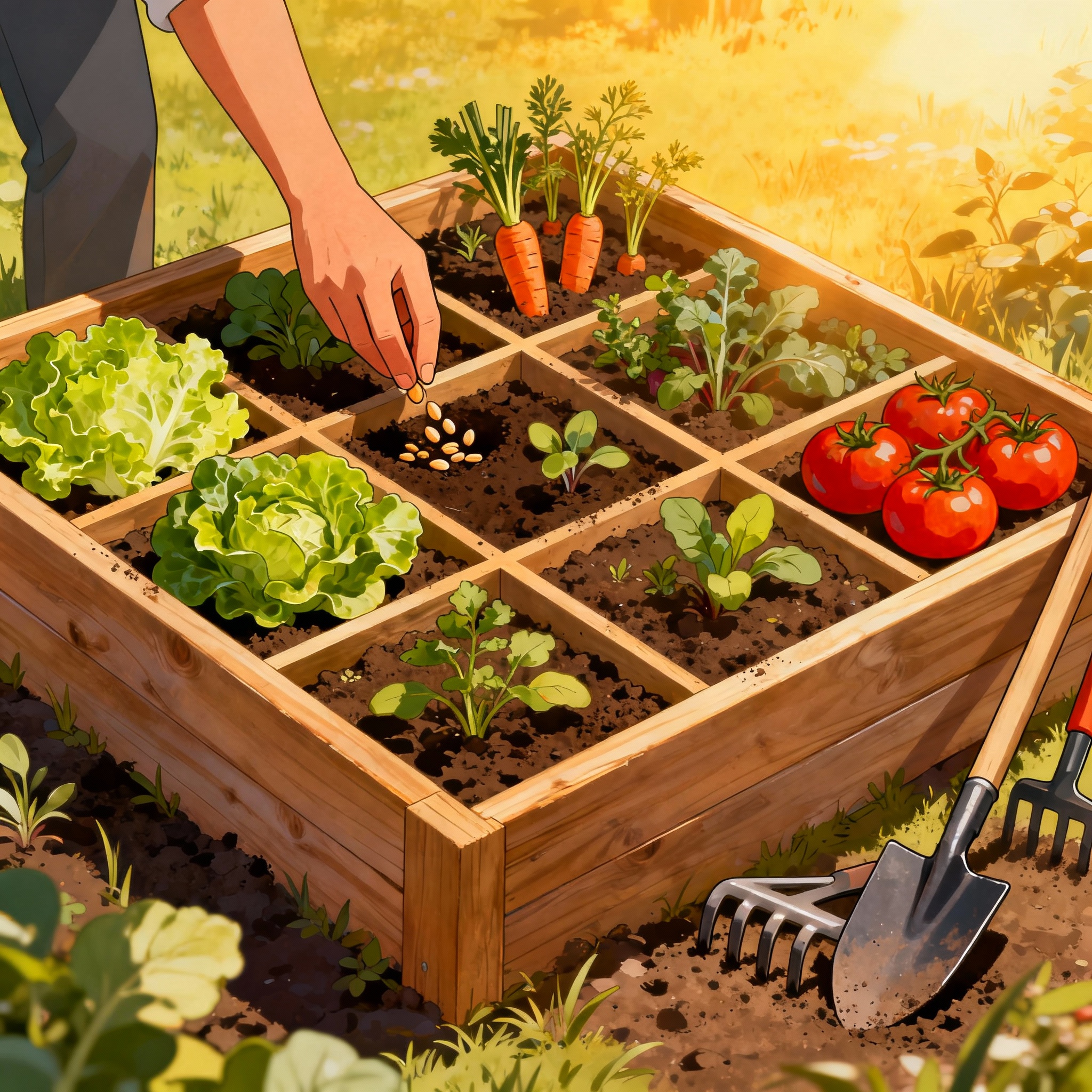Square Foot Garden Planner
Square Foot Gardening Spacing Guide
1 Plant per Square
Large plants: 12″ spacing
- Tomatoes
- Peppers
- Eggplant
- Cabbage
- Broccoli
- Cauliflower
2 Plants per Square
Medium-large plants: 6″ spacing
- Cucumbers (trellis)
- Melons (small varieties)
- Summer Squash
4 Plants per Square
Medium plants: 6″ spacing (grid)
- Lettuce (head)
- Swiss Chard
- Corn
- Marigolds
- Parsley
8 Plants per Square
Compact plants: 3″ spacing
- Peas
- Pole Beans (trellis)
- Arugula
9 Plants per Square
Small plants: 4″ spacing (3×3 grid)
- Bush Beans
- Beets
- Spinach
- Turnips
- Basil
16 Plants per Square
Tiny plants: 3″ spacing (4×4 grid)
- Radishes
- Carrots
- Onions (sets)
- Garlic
- Mesclun greens
💡 Spacing Tips
- ✓ Create physical grid with string or wood strips for accuracy
- ✓ Plant in center of each grid square for optimal spacing
- ✓ Use trellis for vining plants to maximize vertical space
- ✓ Succession plant quick crops like radishes every 2 weeks
- ✓ Harvest and replant squares as crops finish
Square Foot Gardening Method
📏 Bed Specifications
Standard dimensions:
- 4×4 feet (16 squares)
- 3×6 feet (18 squares)
- 4×8 feet (32 squares)
Depth: 6-12 inches
Width: Maximum 4 ft for easy reach
Grid: 1×1 ft squares marked with string/wood
🌱 Mel’s Mix (Soil Recipe)
Equal parts by volume:
- ⅓ Compost (mixed varieties)
- ⅓ Peat moss or coco coir
- ⅓ Vermiculite (coarse)
Benefits:
- Perfect drainage and aeration
- Nutrient-rich
- Weed-free
- Lightweight
✅ Core Principles
Method basics:
- Raised beds divided into 1 ft squares
- Plant by spacing needs, not rows
- Vertical growing with trellis
- Succession planting
- No walking in beds (no compaction)
- Continuous harvest and replant
💰 Benefits
Why Square Foot Gardening?
- 80% less space than row gardens
- 20% of water traditional gardens use
- No weeds in quality soil mix
- Higher yields per square foot
- Easy to maintain and harvest
- Perfect for small spaces
- Accessible (raised beds)
🛠️ Setup Steps
Getting started:
- 1. Build 4×4 or 4×8 raised bed
- 2. Line bottom with landscape fabric
- 3. Fill with Mel’s Mix
- 4. Create 1×1 ft grid with string
- 5. Plan crop layout by spacing
- 6. Plant in center of squares
- 7. Water and maintain
📅 Succession Planting
Maximize productivity:
- Plant fast crops every 2 weeks
- Radishes: 25-30 days
- Lettuce: 45-60 days
- Spinach: 40-50 days
- Bush beans: 50-60 days
- Replant harvested squares immediately
- Keep garden productive all season
📐 Sample 4×4 Layout
16-square bed plan:
- Square 1: 1 Tomato
- Square 2: 1 Pepper
- Square 3: 4 Lettuce
- Square 4: 4 Lettuce
- Square 5: 1 Cabbage
- Square 6: 9 Spinach
- Square 7: 9 Bush Beans
- Square 8: 16 Carrots
- Square 9: 16 Radishes
- Square 10: 16 Onions
- Squares 11-12: 2 Cucumbers (trellis)
- Squares 13-16: 36 Mixed greens
🌿 Vertical Growing
Maximize space:
- Add trellis on north side (no shade)
- Grow cucumbers, peas, beans vertically
- Tomatoes in cages (1 per square)
- Melons in hammocks on trellis
- Increases yield by 50-100%
- Easier harvesting
- Better air circulation
Square Foot Gardening Calculator User Guide
What It Does:
Calculate how many plants fit in your square foot garden bed and plan efficient intensive planting layouts using the Square Foot Gardening method.
How to Use:
📐 Calculator Tab
- Select Plant:
- Choose from 14 common vegetables
- Auto-displays plants per square foot
- Shows spacing pattern and notes
- Enter Number of Squares:
- How many 1×1 ft squares you’ll plant
- Each square = 1 square foot
- Calculate:
- Click “Calculate Plants”
- Results show:
- Total plants for your space
- Squares used
- Plants per square
- Bed requirements
📊 Spacing Guide Tab
Quick reference for plants per square foot.
Categories:
- 1 per square (12″ spacing): Tomatoes, peppers, cabbage, broccoli
- 2 per square (6″ spacing): Cucumbers, small melons
- 4 per square (6″ grid): Lettuce, chard, corn
- 8 per square (3″ spacing): Peas, pole beans
- 9 per square (4″ grid): Bush beans, beets, spinach
- 16 per square (3″ grid): Radishes, carrots, onions
📖 SFG Guide Tab
Complete Square Foot Gardening reference.
Topics Covered:
- Bed Specifications: Standard sizes and grid layout
- Mel’s Mix: Famous soil recipe (⅓ each compost, peat, vermiculite)
- Core Principles: Method basics and philosophy
- Benefits: 80% less space, 20% water, higher yields
- Setup Steps: How to build and start
- Succession Planting: Continuous productivity tips
- Sample Layout: Example 4×4 bed plan
- Vertical Growing: Trellising for maximum space
Square Foot Gardening Basics:
Standard Bed Sizes:
- 4×4 feet = 16 squares
- 3×6 feet = 18 squares
- 4×8 feet = 32 squares
Mel’s Mix (Soil Recipe):
- ⅓ Compost (mixed varieties)
- ⅓ Peat moss or coco coir
- ⅓ Vermiculite (coarse)
Plants Per Square:
- 1: Large (12″ spacing)
- 4: Medium (6″ in 2×2 grid)
- 9: Small (4″ in 3×3 grid)
- 16: Tiny (3″ in 4×4 grid)
Sample 4×4 Garden (16 squares):
text[1 Tomato] [1 Pepper] [4 Lettuce] [4 Lettuce]
[1 Cabbage] [9 Spinach] [9 Beans] [16 Carrots]
[16 Radish] [16 Onions] [Cucumber] [Cucumber]
[Greens] [Greens] [Greens] [Greens]
Yields: 2 large plants, 8 lettuce, 9 spinach, 9 beans, 16 carrots, 16 radishes, 16 onions, 2 cucumbers, plus continuous greens!
Quick Tips:
✅ Create physical grid – Use string or wood strips
✅ Plant in center – Of each 1×1 ft square
✅ Use vertical space – Trellis on north side
✅ Succession plant – Replant as you harvest
✅ No walking in beds – Prevents soil compaction
✅ Mel’s Mix only – No native soil needed
Pro Tip: Square Foot Gardening produces 5× more vegetables in 20% of the space compared to traditional row gardens! A single 4×4 bed (16 sq ft) can feed one person with fresh salad greens all season plus dozens of tomatoes, peppers, and other vegetables. Perfect for small yards, patios, or balconies!

Angelina Everly leads the editorial desk at Live Green Gardens, blending practical plant care, hands-on product testing, and approachable outdoor styling. She focuses on step-by-step how-tos, buyer’s guides, and small-space makeovers that work in real life and real budgets. When she’s not comparing pruning shears or setting up a drip kit, you’ll find her creating cozy corners with planters, solar lights, and pollinator-friendly picks—always with clear pros/cons and safety notes so you can buy once and garden happy.

